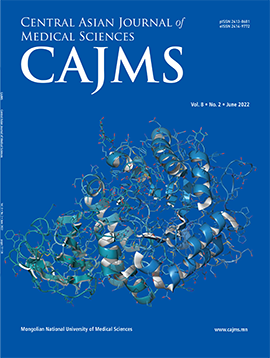Analysis of the Intestinal Lactobacillus and Bifidobacterium among Mongolian Adults, and Their Associated Host Factors
DOI:
https://doi.org/10.24079/cajms.2019.09.008Keywords:
Colony-forming unit, Gut microbiota, Lactobacillus, Mongolia, BifidobacteriumAbstract
Objectives: To characterize gut Lactobacillus and Bifidobacterium and identify the factors shaping its composition, we collected fecal samples from healthy Mongolians residing in various regions of Mongolia. Methods: This was a population-based cross-sectional study involving 256 relatively healthy adults between July 2018 and February 2019. Fecal samples were collected for bacterial analysis using culture method and the species of Bifidobacterium spp. and Lactobacillus spp. were determined by PCR. Results: The participants had a mean age of 38.9 ± 12.8 years. The abundance of Lactobacillus was weakly negatively correlated with grams of fats, potato, cereals foods consumed per day (r = -.20; r = -.16 and r = -.18 respectively). Significant differences in the counts of Lactobacillus were identified depending on the quantity of milk products consumed per day. In adult intestinal tracts, B. bifidum was the most common Bifidobacterium taxon at 29% (31 participants) followed by B. angulatum 13.1% (14), B. adolescentis 9.3% (10) B. catenulatum group 9.3% (10), B. longum 8.4% (9). B. lactis, B. breve, B. dentium and B. gallicum were subdominant species. Conclusion: The Lactobacillus abundance in healthy adults was higher in the region of Khangai, Eastern and Western Mongolia than other locations. The composition of Lactobacillus species varied. Significant but modest correlations were found between amounts of fiber, fats, potatoes consumed, and the amount of Lactobacillus.
Downloads
264
Downloads
Published
How to Cite
Issue
Section
License
Copyright (c) 2019 Mongolian National University of Medical Sciences

This work is licensed under a Creative Commons Attribution-NonCommercial 4.0 International License.




